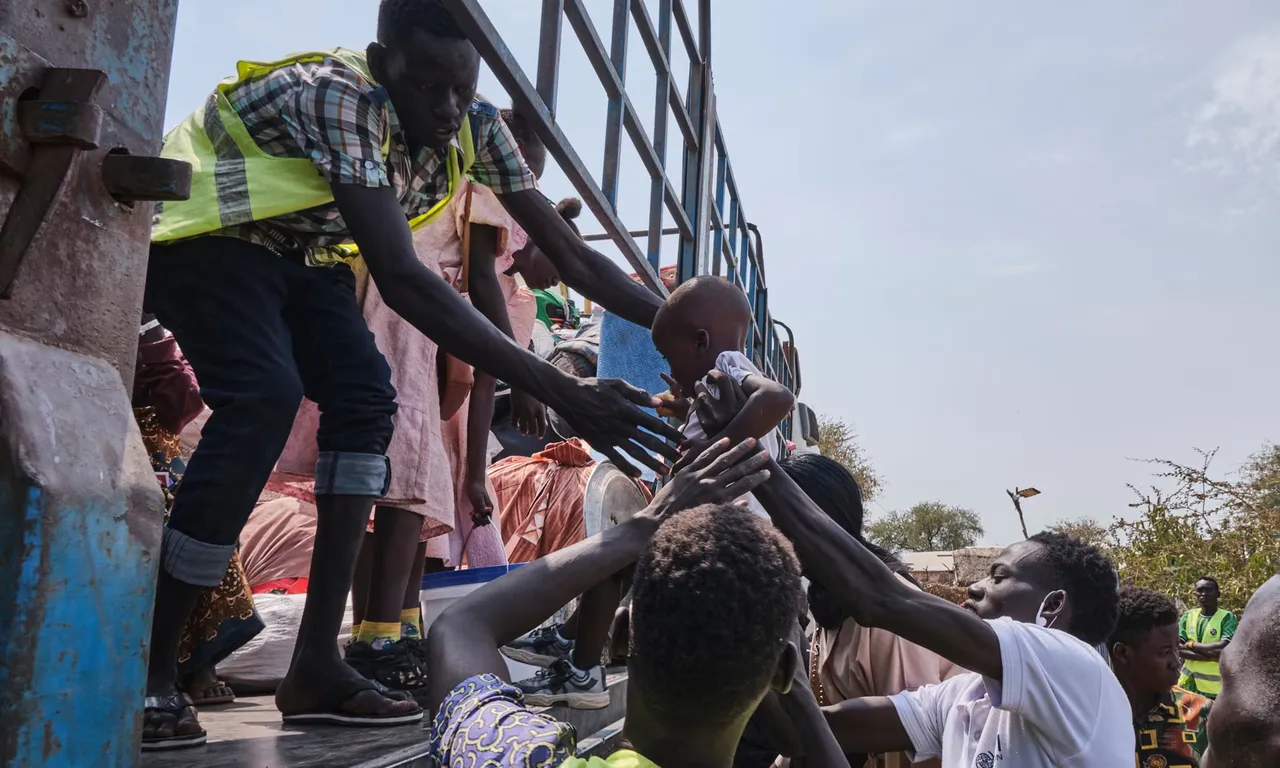
Aid workers pass a refugee baby on to a truck transporting people displaced by the war in Sudan to Renk, South Sudan, in February 2025. Photograph: Diego Menjíbar Reynés/The Guardian
In a Sudan consumed by flames, every rule of war has been broken. Mass graves, rape, sieges, indiscriminate bombings, and a population starved into submission: this is a tragedy that deserves the world’s full attention. Instead, darkness falls.
In the near-total silence of the international media, Sudan sinks deeper each day into the abyss of barbarity. More than two years since the outbreak of civil war between the Sudanese Armed Forces (SAF), led by General Abdel Fattah Al-Burhan, and the Rapid Support Forces (RSF) under General Mohammed Hamdan Dagalo, the conflict has taken on apocalyptic proportions.
Not only because of the death toll—over 27,000 according to Amnesty International—or the millions displaced, but because of the nature of the horrors, which evoke genocidal scenarios. The latest revelation: mass graves near Salha, on the outskirts of Khartoum, where dozens of bodies have been dumped in containers—mute witnesses to summary executions and systematic rape.
Sudan, the third-largest country in Africa, is now the stage for a war between two factions, both born from military coups. On one side, Al-Burhan, head of a military government that seized power in 2021. On the other, the RSF, a paramilitary group originally allied with the government but turned rebel after breaking the democratic transition agreements.
The conflict erupted on April 15, 2023, and has since engulfed the entire country, splitting Sudan into shifting zones of control: the north and east under SAF, while the west and south—including the strategic Darfur region—are firmly in RSF hands.
At the heart of the conflict is Darfur, a region rich in gold and minerals, already infamous for the ethnic cleansing of the early 2000s. Today, it is almost entirely under RSF control, with its resources exploited to fund the war and bolster the militia's arsenal.
In recent months, Dagalo’s militias have deployed armed drones to strike strategic targets—including Port Sudan, the provisional administrative capital—bombing the airport, seaport, and fuel depots, forcing the UN to suspend humanitarian flights. It is the first time a Sudanese faction has used such weapons with this level of effectiveness, drastically shifting the balance of power.
The massacre was confirmed with the discovery of mass graves in Salha. Metal containers filled with corpses reveal systematic executions of civilians. Added to these are dozens of accounts from NGOs and independent observers reporting mass rape, violence against minors, and the destruction of entire villages.
According to Amnesty International, rape is being used as a deliberate weapon of war. The 2024–2025 report documents 27,000 confirmed deaths and 33,000 injured in less than two years—likely an underestimation. Over 80% of the country’s hospitals are no longer operational, and two-thirds of the population lack access to medical care.
The RSF’s reach is not limited to Darfur. The militia has surrounded El-Fasher, one of the last government strongholds in North Darfur. The siege has triggered new waves of refugees fleeing to Chad, which already hosts over 1.3 million Sudanese. In the past two weeks alone, at least 20,000 people have crossed the border, facing looting, rape, extortion, and often death from exhaustion or transport conditions.
Meanwhile, Port Sudan—a key logistical hub and seat of temporary ministries—is under attack. Initially spared by the war, it has become a strategic target: bombings have hit its port and airport, and the UN now reports an inability to deliver humanitarian aid there.
Behind the internal conflict, regional and global powers are at play. The most serious accusations are aimed at the United Arab Emirates and Chad, both suspected of supplying the RSF. According to UN sources, eastern Chad has facilitated arms transfers to the RSF through two border airports.
The Emirates, meanwhile, have been accused by Al-Burhan of complicity in the “genocide of the Masalit community”—claims not fully proven, but supported by reports of suspicious arms shipments and the RSF’s access to sophisticated weaponry.
International reports confirm that the RSF has received arms from other sources as well, including Russia, China, and Turkey. Government forces, for their part, are not free of blame: the conflict has revealed a horrifying symmetry of cruelty. Both sides use terror as a weapon, and no meaningful diplomatic path is in sight.
Sudan today is a laboratory of atrocities largely ignored by the international community. Official condemnations—even joint statements by the United States and United Nations after RSF attacks on Zamzam and the killing of Red Cross workers—amount to little more than empty words.
The contrast with the global political and media mobilization over other crises, such as Gaza or Ukraine, is stark. Lacking powerful allies and without a dominant narrative on its side, Sudan risks being erased from collective memory—even as a massacre unfolds.